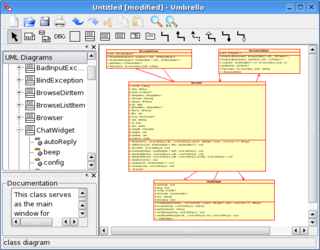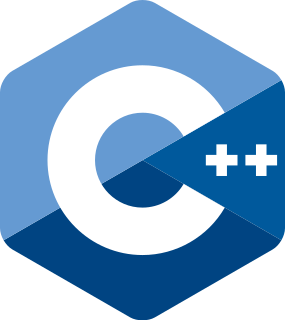
An application-specific integrated circuit is an integrated circuit (IC) customized for a particular use, rather than intended for general-purpose use. For example, a chip designed to run in a digital voice recorder or a high-efficiency bitcoin miner is an ASIC. Application-specific standard products (ASSPs) are intermediate between ASICs and industry standard integrated circuits like the 7400 series or the 4000 series.
Software development is the process of conceiving, specifying, designing, programming, documenting, testing, and bug fixing involved in creating and maintaining applications, frameworks, or other software components. Software development is a process of writing and maintaining the source code, but in a broader sense, it includes all that is involved between the conception of the desired software through to the final manifestation of the software, sometimes in a planned and structured process. Therefore, software development may include research, new development, prototyping, modification, reuse, re-engineering, maintenance, or any other activities that result in software products.

Computer-aided software engineering (CASE) is the domain of software tools used to design and implement applications. CASE tools are similar to and were partly inspired by computer-aided design (CAD) tools used for designing hardware products. CASE tools are used for developing high-quality, defect-free, and maintainable software. CASE software is often associated with methods for the development of information systems together with automated tools that can be used in the software development process.
Orchestration is the automated configuration, coordination, and management of computer systems and software.

Ben Shneiderman is an American computer scientist, a Distinguished University Professor in the Department of Computer Science, which is part of the University of Maryland College of Computer, Mathematical, and Natural Sciences at the University of Maryland, College Park, and the founding director (1983-2000) of the University of Maryland Human-Computer Interaction Lab. He conducted fundamental research in the field of human–computer interaction, developing new ideas, methods, and tools such as the direct manipulation interface, and his eight rules of design.
Software visualization or software visualisation refers to the visualization of information of and related to software systems—either the architecture of its source code or metrics of their runtime behavior- and their development process by means of static, interactive or animated 2-D or 3-D visual representations of their structure, execution, behavior, and evolution.
Anatoly Abramovich Shalyto is a Russian scientist, doctor of sciences, professor, awarded by Russian State Government in 2008 for achievements in education, developer of technology for Automata-based programming named "Switch-technology", initiator of Open Project Documentation Initiative and of "Save the best in the universities of Russia".
A software design description is a written description of a software product, that a software designer writes in order to give a software development team overall guidance to the architecture of the software project. An SDD usually accompanies an architecture diagram with pointers to detailed feature specifications of smaller pieces of the design. Practically, the description is required to coordinate a large team under a single vision, needs to be a stable reference, and outline all parts of the software and how they will work.
Threat modeling is a process by which potential threats, such as structural vulnerabilities can be identified, enumerated, and prioritized – all from a hypothetical attacker’s point of view. The purpose of threat modeling is to provide defenders with a systematic analysis of the probable attacker’s profile, the most likely attack vectors, and the assets most desired by an attacker. Threat modeling answers questions like “Where are the high-value assets?”, “Where am I most vulnerable to attack?”, “What are the most relevant threats?”, and “Is there an attack vector that might go unnoticed?”.
Keyword-driven testing, also known as table-driven testing or action word based testing, is a software testing methodology suitable for both manual and automated testing. This method separates the documentation of test cases -including the data to use- from the prescription of the way the test cases are executed. As a result, it separates the test creation process into two distinct stages: a design and development stage, and an execution stage. The design substage covers the requirement analysis and assessment and the data analysis, definition, and population.
The Architecture Design and Assessment System (ADAS) was a set of software programs offered by the Research Triangle Institute from the mid-1980s until the early 1990s.
Duolog Technologies was an Irish-based company that developed electronic design automation tools that assist with the integration of complex System-on-Chip(SoC), ASIC and FPGA designs. In 2014, Duolog was acquired by ARM Holdings plc, a multinational semiconductor and software design company headquartered in Cambridge, United Kingdom.
Software archaeology or software archeology is the study of poorly documented or undocumented legacy software implementations, as part of software maintenance. Software archaeology, named by analogy with archaeology, includes the reverse engineering of software modules, and the application of a variety of tools and processes for extracting and understanding program structure and recovering design information. Software archaeology may reveal dysfunctional team processes which have produced poorly designed or even unused software modules. The term has been in use for decades, and reflects a fairly natural metaphor: a programmer reading legacy code may feel that he or she is in the same situation as an archaeologist exploring the rubble of an ancient civilization.
Test management tools are used to store information on how testing is to be done, plan testing activities and report the status of quality assurance activities. The tools have different approaches to testing and thus have different sets of features. Generally they are used to maintain and plan manual testing, run or gather execution data from automated tests, manage multiple environments and to enter information about found defects. Test management tools offer the prospect of streamlining the testing process and allow quick access to data analysis, collaborative tools and easy communication across multiple project teams. Many test management tools incorporate requirements management capabilities to streamline test case design from the requirements. Tracking of defects and project tasks are done within one application to further simplify the testing.
Prosa UML Modeller assists software developers to design applications visually by using Unified Modeling Language. Unified Modeling Language - UML , is a standardized graphic notation developed to create visual models of object oriented software systems.
ISO/IEC/IEEE 29119Software and systems engineering -- Software testing is a series of five international standards for software testing. First developed in 2007 and released in 2013, the standard "defines vocabulary, processes, documentation, techniques, and a process assessment model for testing that can be used within any software development lifecycle."
Tricentis Tosca is a software testing tool that is used to automate end-to-end testing for software applications. It is developed by Tricentis.





